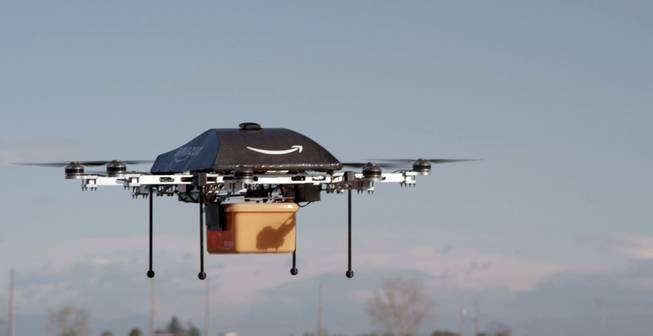
Amazon / AP
This undated image provided by Amazon.com shows the so-called Prime Air unmanned aircraft project that Amazon is working on in its research and development labs.
Tuesday, Dec. 31, 2013 | 2 a.m.
Two years of work preceded Monday’s announcement that Nevada had received the Federal Aviation Administration’s drone test designation, positioning the state to become a hotbed for commercialization of the unmanned aerial vehicle industry.
But now that Nevada has won its hard-fought bid, the question is ... now what?
“It would be like saying in the Civil War days, what’s the railroad going to be like?” said Sen. Harry Reid, D-Nev., one of the project’s biggest boosters, in an interview Monday morning with the Sun. “It’s in its infancy, and I think we can speculate. But I really don’t know.”
Nevada based its bid on a series of factors, which its authors repeated with the punctuation of vindication Monday: The state has large stretches of rural areas, more than 320 days of clear skies per year and more restricted airspace than all other 49 states combined. In other words, the state is ready to fly.
But the bid’s backers admitted that it would take a lot of doing to actually get from the approved bid to drones in the sky over the next 180 days — the amount of time the FAA has given Nevada to get its test operations off the ground.
“It will remain a competitive process throughout,” said Steve Hill, head of the Nevada Governor’s Office of Economic Development. “But it is a real opportunity.”
The state’s political, educational, research and business leaders are salivating over what they predict will be a $2.5 billion opportunity to bring 12,000 to 15,000 jobs to the state, at an average income of $62,000.
Gov. Brian Sandoval sees the designation as one of only six “anchor tenant[s]” for the commercial drone industry as a long-awaited engine of economic diversification.
“It will open up a whole new world to the people of our state for education and job opportunities,” Sandoval said Monday. “This is a day that 10 years from now and 20 years from now, we’ll look back on and see that it really changed the trajectory of our economic development efforts.”
But there are some less lofty first steps to take before any UAVs get off the ground.
There is a contract to sign with the FAA. The state also must submit an action plan to the FAA and get the agency to certify it.
Then there’s the matter of bringing in the companies that will actually do the work, contracting their projects, and dividing up the airspace they’ll need to use in the four test zones: Boulder City Municipal Airport and Desert Rock Airstrip in the southern part of the state, and Fallon and Stead in the north.
That all represents months of work in itself. But come spring, Hill said, he expects the flights to begin.
“And then from there, we’ll start to see some real growth after that,” he said, though he cautioned: “From a permanent jobs standpoint, that will take a little bit longer.”
Hill explained that Nevada was reaching out to developers focusing on every industry from agriculture to emergency services to wireless communications. The hope, he said, is that interested companies will “either start here and grow in Nevada or decide to locate here in the state” — and the team would be trying to think outside the box to maximize opportunities for innovation and investment.
Though Nevada will still have to compete with five other FAA-designated test areas nationally, state leaders hope that the months ahead will yield more room for collaboration. Each site was selected for different qualities, and the FAA determined Nevada’s bid “contributes to geographic and climatic diversity.” It is the only test site in the West, save for one range location in Oregon that was a part of the University of Alaska’s bid. The next closest test locations are in North Dakota and Texas.
The FAA’s goal is to begin integrating unmanned aerial vehicles into commercial airspace by September 2015. Given that timeline, state organizers hope the local industry will be up and running late 2014.
But while they hope the state sees the economic benefits of this new opportunity by then, that might be all Nevadans should expect to see of the new backyard drone industry for a while.
“None of these platforms are you going to see flying over anybody’s house,” Hill said. “I doubt if anybody in our urban or our rural areas is even going to see them.”

Join the Discussion:
Check this out for a full explanation of our conversion to the LiveFyre commenting system and instructions on how to sign up for an account.
Full comments policy